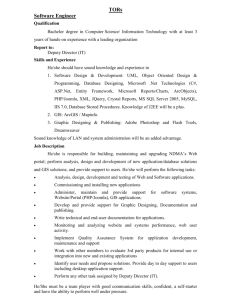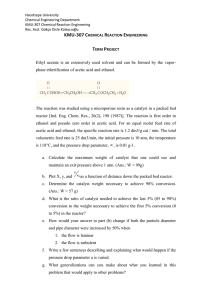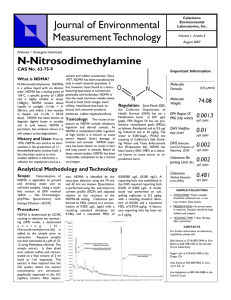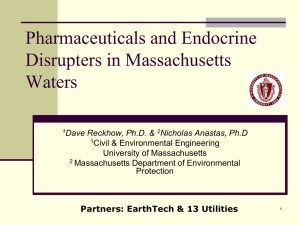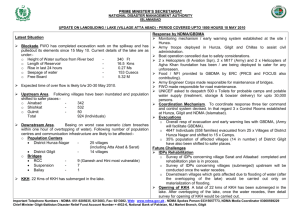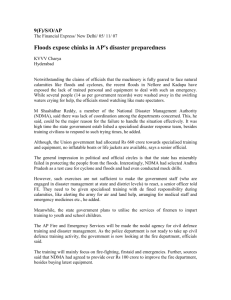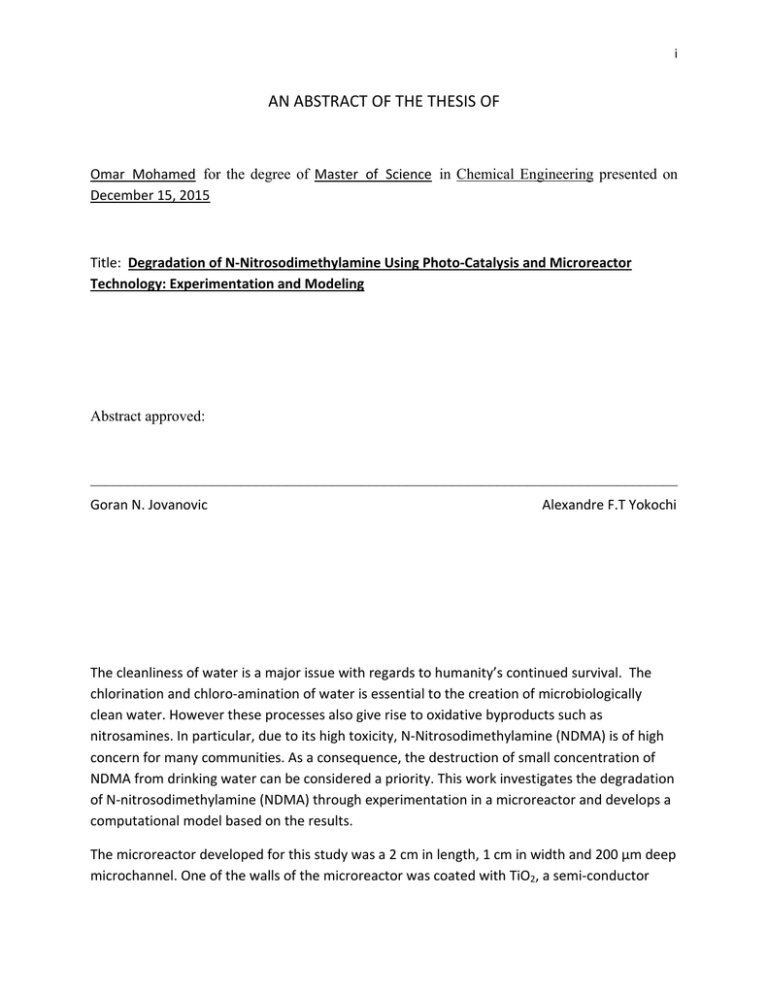
i AN ABSTRACT OF THE THESIS OF Omar Mohamed for the degree of Master of Science in Chemical Engineering presented on December 15, 2015 Title: Degradation of N‐Nitrosodimethylamine Using Photo‐Catalysis and Microreactor Technology: Experimentation and Modeling Abstract approved:
______________________________________________________________________________
Goran N. Jovanovic Alexandre F.T Yokochi The cleanliness of water is a major issue with regards to humanity’s continued survival. The chlorination and chloro‐amination of water is essential to the creation of microbiologically clean water. However these processes also give rise to oxidative byproducts such as nitrosamines. In particular, due to its high toxicity, N‐Nitrosodimethylamine (NDMA) is of high concern for many communities. As a consequence, the destruction of small concentration of NDMA from drinking water can be considered a priority. This work investigates the degradation of N‐nitrosodimethylamine (NDMA) through experimentation in a microreactor and develops a computational model based on the results. The microreactor developed for this study was a 2 cm in length, 1 cm in width and 200 µm deep microchannel. One of the walls of the microreactor was coated with TiO2, a semi‐conductor ii photo‐catalyst, and activated through the use of lower energy UV‐A light. Reactor effluent was characterized using a cationic and anionic ion chromatograph. The results showed superior degradation of NDMA when compared to similar studies which utilized more conventional suspended particle batch reactors, with the microreactor degrading NDMA by approximately 90% in 5 minutes. Measurements of dimethylamine, NO+, and methylamine products showed strong correlation to NDMA consumption. Methanol could not be detected using the analytical tool employed and its existence could not be confirmed. Results of the microreactor modeling in COMSOL Multiphysics showed good trend correspondence. The model fit the degradation mechanics of NDMA well but differences between the modelling results and experimental results can be attributed to a shift from a reaction limited reactor to a diffusion limited reactor. The model did not fit the experimental data for methylamine, the experimental data insinuates another reaction consuming methylamine. Based on the modeling results a thinner microchannel would be important for optimal degradation in a microreactor. iii ©Copyright by Omar Mohamed December 15, 2015 All Rights Reserved
iv Degradation of N‐Nitrosodimethylamine Using Photo‐Catalysis and Microreactor Technology: Experimentation and Modeling by Omar Mohamed A THESIS Submitted to Oregon State University in partial fulfillment of the requirements for the degree of Master of Science Presented December 15, 2015 Commencement June 2016 v Master of Science thesis of Omar Mohamed presented on December 15, 2015 APPROVED: Co‐Major Professor, representing Chemical Engineering Co‐Major Professor, representing Chemical Engineering Head of the School of Chemical, Biological and Environmental Engineering Dean of the Graduate School I understand that my thesis will become part of the permanent collection of Oregon State University libraries. My signature below authorizes release of my thesis to any reader upon request. Omar Mohamed, Author
vi ACKNOWLEDGEMENTS The author expresses sincere appreciation to
His Family and Friends
Dr. Goran Jovanovic
Dr. Alexandre Yokochi
Dr. Nick Au Yeung
Dr. Michell Dolgos
Yousef Alanzi
Mrs. Kristen Rorrer
Mrs. Elisha Brackett
Tony (Yu) Miao
Travis Campbell
Dr. Mohammad Azzizian
vii TABLE OF CONTENTS Chapter Page 1 Introduction ..…………………………………………………………………………..…………………………………………….1 1.1 Goals and Objectives ………………………..……………………………………………………………………..3 2 Background ....………..……………………………………………………………………………………………………………...4 3 Theoretical Background ……………………...…………………………………………….………………………………..…7 3.1 Materials and Methodology …………………..………………………..……..…………………………….19 3.2 Reactor Setup, Design and Validation ……...…..………………………………..……………………..23 4 Results and Discussion ………………………………………………………………..……………………………………....29 4.1 Experimental Results ………………………..……………………………………....………………………….29 4.2 Modeling Results .………………………..……………………………………....……………………………….31 4.2 Discussion…………………………………………………..……………………………………....…………………33 5 Conclusion…………………………………………………………………………………………………………………………….38 5.1 Future Work……………………………………………………………………………………………………………38 6 Bibliography ..……………………………………………………………………..………………………………………………..39 viii LIST OF FIGURES Figure Page 1. Photo‐Catalyst Activation Schematic …………………………………………………………….…………...…………2 2. Proposed Photo‐Catalytic NDMA degradation ……………..……………………………….…………...…………5 3. Proposed hydrolysis of DMA …………………..…………………………………………………….…………...…………5 4. TiO2 absorption of AM1.5 Solar Spectrum …………………………………………………….…………...…………5 5. Parameterized COMSOL input ……….……………………………………………………………….…………………….7 6. Non‐parameterized COMSOL input ….…………………………………………………….………………………….17 7. Carbon Balance of COMSOL Model …………………………………………………………….………………………18 8. Nitrogen Balance of COMSOL Model .………………………………………………..……………………………….18 9. Calibration Curve for N‐Nitrosodimethylamine ….……………………………………………………………...19 10. Calibration Curve for Dimethylamine….………………………………………………………………………….…20 11. Calibration Curve for Methylamine….……………………………………………………………………..…………20 12. Calibration Curve for NO+…………………………………….……..………………………………………………….…21 13. Ion Chromatograph output example….…………………………………………………………..……………….…22 14. Photo‐Spectrometer output example….……………………………………………….…………………….………22 15. Reactor design; blow up schematic….…………………………………………………………..………………...…23 16. Pump Assembly….………………………………………………………………………………………………………………24 17. Reactor System Schematic….……………………………………………………………………………..………………25 18. Bare Reactor UV spectrum….………………………………………………………………………………….....………26 19. Catalytic Reactor UV spectrum………………….…………………………………………………….…………………26 20. NDMA UV test photo‐spectrum….…………………………………………………………………..…………………27 ix LIST OF FIGURES (Continued) Figure Page 21. DMA‐Empty Reactor output….……………………………………………………………………………….…….……28 22. MA‐Empty Reactor output….……………………………...…………………………………………..…………………28 23. Experimental Results….………………………………………………………………………………………………………29 24. Experimental Nitrogen Balance….………………………………………………………………………………………30 25. Experimental Carbon Balance….…………………………………………………….……………………………..……30 26. Modeling Results….………………………………………………………………….…………………..……………………31 27. K7 Optimization….………………………………………………………………………………………………………………32 28. K5 Optimization….………………………………………………………………………………………………………………32 29. NDMA: Experimental Vs. Modeling….…………………………………………………………………………………33 30. DMA: Experimental Vs. Modeling….……………………………………………..………………………………...…34 31. NO+: Experimental Vs. Modeling….………………………………………………………………………………….…35 32. MA: Experimental Vs. Modeling….…………………………………………………………………………………..…36 33. Experimental Vs. Literature Results….…………………………………………………….……………….…………37 x LIST OF SYMBOLS (Continued) SYMBOL Units Description e‐ ‐ Electrons h+ ‐ Holes h J ‐ s Planck’s Constant ν ‐ Frequency Vi m‐s‐1 Velocity ρ Kg‐m‐3 Density μ Kg‐m‐1‐s‐1 Viscosity gi m/s2 Gravitational Force DAB m2/s Diffusion Coefficient V r m3 Volume of Reactor kf s‐1 Arbitrary Rate Constant k1 s‐1 Rate Constant k2 m2‐s‐1‐Moles‐1 Rate Constant k3 m2‐s‐1‐Moles‐1 Rate Constant k4 m2‐s‐1‐Moles‐1 Rate Constant k5 m2‐s‐1‐Moles‐1 Rate Constant k6 m2‐s‐1‐Moles‐1 Rate Constant k7 m3‐s‐1‐Moles‐1 Rate Constant 1 1.0 Introduction: The need for clean water and air is a necessity for humanity and the continued growth of humanity on this planet. Current wastewater treatment methods are not sufficient for the removal of many toxic chemicals, especially since many treatment facilities are not expecting or prepared for such contaminants. It is estimated that over 540 million metric tons of toxic chemicals are generated annually at more than 14,000 locations in the United States alone; 70% of these waste sites are the primary cause of human contact with toxic chemicals via groundwater contamination.1 Such staggering statistics raise the question of how ground water can be effectively, efficiently and economically cleaned for safe human consumption. The use of the sun, ultraviolet light and a semi‐
conductor photo‐catalyst open the possibility of providing humanity with cleaner drinking water and air. Photo‐catalysts work based on a very simple electron‐hole pair system that allows the catalyst to break down organic contaminants in air or drinking water. Figure 1 shows a basic diagram of how a photon can create the electron‐hole pair. The electron and hole work separately to initiate a redox reaction. Oxidation occurs via the hole and reduction occurs via the electron on the semi‐conductor catalyst. After a short period of time, 10‐100 nanoseconds, the hole and electron recombine to await another photon to split them apart again1. The reaction time is equal to the time the electron remains excited in the conduction band.2 If water is used as a solvent, the water molecule can actually be broken down into radicals that will spontaneously react with most species in the solvent, forming a reaction pathway for the degradation of contaminants.2 2 Figure 1 shows the process of an incident photon sending a valence electron into the conduction band leaving behind a hole in the valence band. The electron and the hole have a certain amount of time before they recombine, during this period the electron and hole act as reducing or oxidizing agents. The electron loses its energy and falls from the conduction band into the valence band, filling in the hole. The amount of time for reaction is the amount of time the electron stays in the valence band. The major obstacles with this process in classical reactors are: efficiency, high associated energy cost due to the use of ultraviolet lamps or electrical power, and low contaminant removal due to low surface area to volume ratios1. The solution to these issues can be addressed through photo‐catalytic microreactors. Microreactors are reactors that have channel heights of less than 0.5 millimeters. This height allows for an extremely high surface area to volume ratio potentially enhancing the efficiency issue of classical reactors. Since microreactors have such high surface area to volume ratios, it is possible to assume that the energy source could be sunlight, potentially minimizing operating costs. The surface area can further be increased through the use of a conformal coating of the catalyst onto Nano‐springs. The use of both the microreactor and Nano‐springs will greatly enhance our ability to create cleaner drinking water and air. The purpose of this study is not commercialization but is proof of concept via experimental analysis and mathematical modeling. Such experiments and models would be the first step into investigating whether or not a microreactor configuration is possible for the removal of toxic organic contaminants that have been introduced into drinking water and air. 3 1.2 Goals and objectives: The major goal for this work: 1. Obtain experimental and modeling evidence that photo‐catalytic degradation of NDMA in aqueous solution using a microreactor is feasible The objectives necessary to achieve these goals are listed below: a. Define reaction mechanism for NDMA degradation in photo‐catalytic microreactor b. Define mathematical model for momentum transfer and mass transfer c. Validate computational model d. Design, manufacture and assemble a photo‐catalytic microreactor e. Design and characterize TiO2 catalyst f.
Design instrumentation systems necessary to support experimentation and calibrate accordingly g. Perform experiments h. Reconcile modeling data and experimental data i.
Define recommendations for future work 4 2.0 Background: Toxic contaminants in drinking water: The need for clean water and air is a necessity for humanity. Current wastewater treatment facilities are not sufficient for the removal of many toxic chemicals, these treatment facilities are generally unprepared for such contaminants. Some common contaminants that are difficult to remove from wastewater are 1,4 Dioxane,3 N‐nitrosodimethylamine, Ibuprofen,4 Naproxen,5 Bishphenol A,5 Primidone and many more. 6,7 With the amount of toxic chemicals generated increasing on an annual basis, there is a need for more refined and efficient methods of waste water treatment. This is especially true when considering the difficulty of extracting or breaking down some of the toxic chemicals. Compounds such as NDMA have been found in water supplies across the country even places such as Orange County, California.8 NDMA: NDMA has no practical industrial use and is a byproduct of chlorination and chloro‐amination of water for disinfecting purposes.9 The EPA has classified NDMA as a highly probable human carcinogen.10 In vitro studies in mammalian and bacterial cells show NDMA to be a mutagen. In‐vivo studies have shown genetic defects caused by NDMA.9 The state of Massachusetts has a regulatory limit of 10 nanograms per liter, while California has a limit of 7 nanograms per liter.11 The most prominent study in the degradation of NDMA utilized a batch reactor to degrade NDMA modifying both temperature and pH and monitoring the effects. The study showed that temperature had no major effect on reaction rate while a pH change from 7 to 9 almost completely halted the reaction.12 Other studies examined the use of UV light to remove NDMA, usually a peroxide to assist in the degradation.8 This is outside the scope of this research but is significant due to the discrepancy between degradation products. While the major products of Dimethylamine, methylamine and Nitrate/Nitrite are generally constant throughout literature, the formation of formate or formaldehyde varies.8,12 Many studies have attempted to develop a reaction mechanism for the breakdown of NDMA 5 via photo‐catalysis but none were used for this specific research since they did not match the experimental results. 12,9 Below is a proposed overall reaction scheme for this study. Figure 2 shows the degradation of N‐Nitrosodimethylamine (NDMA) in the presence of TiO2, water a light source breaking +
down into dimethylamine (DMA) and a nitrosyl group (NO ). This reaction requires the presence of the TiO2 catalyst and can therefore only occur at the catalyst surface. The reaction shown in Figure 2 can only occur on the catalyst surface. It is also proposed that DMA undergoes hydrolysis to form the products of methylamine (MA) and methanol (MeOH). Below is a schematic of the proposed reaction. Figure 3 shows DMA undergoing hydrolysis to produce MA and MeOH. This reaction only requires water and can therefore occur anywhere in the reactor. Micro Technology Definition, History and Benefits: Microreactors are reactors that have channel heights that are less or equal to 1 millimeter and varying channel lengths.13 This height coupled with the small amount of volume passing through allows for an extremely high surface area to volume ratio potentially improving the volume to surface area deficiency issues of classical catalytic reactors. Microreactors scale down classical systems, allowing for diffusion to occur quickly. This has particularly great implication for catalytic systems, which often are diffusion limited. 6 Catalyst: The catalyst used in this study is a titanium dioxide (titania) semi‐conductor photo‐catalyst. The stability of titania coupled with it being a semi‐conductor makes it ideal for use in waste water remediation. However, titania has a maximum band gap energy or 3.2 eV or maximum absorption wavelength of approximately 400 nm, which is outside of the range of visible light as shown below.14 Figure 4 shows the AM 1.5 solar spectrum, the area in red illustrates the light thatTiO2 can utilize for creation of an electron hole pair. This bandgap restricts the use of unmodified TiO2 to the ultraviolet range. The catalyst used in this study was also further enhanced allowing for an even greater surface area to volume ratio in the microreactor. Nano‐spring technology was used with a coating of titania to enable the photo‐catalytic degradation. Modifying the TiO2 (titania) catalyst could lead to sunlight being the activator of the catalyst, making operating costs essentially negligible.15,16,17 However for this study, low energy ultraviolet light was used. The purpose of this study is not commercialization but is proof of concept via experimentation and mathematical modeling. 7 3.0 Theoretical background Mathematical model: The mathematical model is based on three fundamental building blocks: the momentum balance, the material balance and the reaction mechanism. The momentum and material balances are derived from first principles while the reaction mechanism is derived from previous works and experimental results. Below you will find a simple schematic of the system as it is modeled in the modeling software. Figure 5 shows the details of the COMSOL model of the microreactor including the value for the channel length, channel height and direction of flow. The COMSOL model was a two dimensional model, it was assumed that the reactor was infinitely wide compared to the reactor height and length, and therefore does not include a reactor width. The catalyst thickness was also ignored for the COMSOL model, therefore the catalyst acts as a wall. Momentum Balance: The Navier‐Stokes equations are shown, with no simplifications, below by Equations 7. d 2V d 2V d 2V
dVx
dV
dV
dV
dP
Vx x Vy x Vz x
2x 2x 2x
dx
dy
dz
dx
dy
dz
dt
dx
g x
(7a) d 2Vy d 2Vy d 2Vy
dVy
dVy
dVy
dVy
dP
Vx
Vy
Vz
2
2 g y
dx
dx
dy
dz
dy
dy 2
dz
dt
(7b) d 2Vz d 2Vz d 2Vz
dVz
dVz
dVz
dVz
dP
Vx
Vy
Vz
2 2 2 g z
dx
dy
dz
dz
dy
dz
dt
dx
(7c) 8 The system is assumed to be at steady state, isothermal, one directional flow with an incompressible liquid. The continuity equation is shown by Equation 8. Following the continuity equation are several mathematical simplifications of the system. dVx dVy dVz dV
0
dy
dz dt
dx
Vy 0 , Vz 0 , (8) dV
dV
dVx
dP
0 , 0 (Continuity), x 0 , g x 0 , 0 dz
dt
dx
dy
d 2V
dP
d 2Vx
d 2V
0 , 2 0 , 2x 0 , 2x 0 dz
dx
dz
dy
The mathematical simplifications are applied to Equations 7. Equations 7b and 7c are completely canceled out and Equation 7a is simplified to Equation 9. d 2Vx
2
dy
dP
dx
(9) The pressure drop across the system can be assumed to be linear and constant, if this is done it would require the use of 10a and 10b as boundary conditions. The boundary conditions are both no slip boundary conditions. The boundary conditions are shown below, with Equation 10a being the no slip boundary condition for the non‐catalyst wall, and Equation 10b being the no slip boundary condition for the catalyst wall. @ y Lcat ;Vx 0 (10a) @ y Lwall ;Vx 0 (10b) 9 Material Balance: The mass transfer equations were derived from first principles and are what COMSOL Multiphysics used to calculate the mass transfer capabilities of individual species. The individual inputs and outputs for the system were examined, one axis at a time. Convective transfer only occurs in the direction of flow, the x‐coordinate, and flow is laminar. Diffusion occurs in and out of every coordinate. Mathematically this is shown by Equations 14. dC A
dC A
Vx yyC A x Vx yyC A x x DAB yz
DAB yz
dx x
dx x x
(14a)
dC A
dC A
DAB xz
DAB xz
dy y
dy y y
(14b) dC A
dC A
DAB xy
DAB xy
dz z
dz z z
(14c) xyzkC A 0 (14d) Where Equation 14a represents the diffusion and convection in the x‐plane, Equation 14b represents the diffusion in the y‐plane, Equation 14c represents the diffusion in the z‐plane and Equation 14d represents the reaction that occurs in the bulk media. DAB represents the diffusion coefficient of any contaminant species in water, CA represents the concentration of contaminant “A”, Vr represents the reactor volume, and Vx represents the velocity profile which is only in the x‐direction. If Equations 14 are divided by (ΔxΔyΔz), the limit of each equation is taken, steady state is assumed and Equations 14 are added together then the differential form of the mass transfer equation is born. Equation 15 is the differential mass balance, as shown below. Vx
dC A
d 2C A
d 2C A
d 2C A
DAB
D
D
k f C A 0 AB
AB
dx
dx 2
dy 2
dz 2
(15) 10 Please note that the reaction term is left in since the system being examined does contain reactions in the bulk and on the catalyst surface. The material balance can be further simplified by removing the z‐
coordinate term from equation 15. The Z‐direction is assumed to be negligible and the term goes to zero. Equation 16 shows the simplified material balance. Vx
dC A
d 2C A
d 2C A
DAB
D
k f C A 0 AB
dx
dx 2
dy 2
(16) The general form of the mass balance can now be used for each specific species. The equation below shows the material balance for N‐nitrosodimethylamine (NDMA). dCNDMA
d 2CNDMA
d 2CNDMA
Vx
DNDMA H 2O
DNDMA H 2O
0 dx
dx 2
dy 2
(17) Notice that the bulk reaction term is not present in the material balance for NDMA, which is because NDMA does not react in the bulk, it only reacts on the catalyst surface. In order to solve this equation 3 boundary conditions are needed. All three are shown mathematically below. k3 h
dC NDMA
k5 NDMA DNDMA H 2O
k4
dy
y Lcat
(18)
dC NDMA
0 DNDMA H 2O
dy y Lwall
CNDMA x 0 1.4mM
dCNDMA
0 dx x 0
(19) (20) Equation 18 is the first boundary condition for NDMA and allows us to model the surface reaction by setting the flux into the catalytic wall equal to the rate of reaction. Equation 19 is the second boundary condition and shows that no species can diffuse across the solid wall at Lwall. Equation 20 is our last 11 boundary condition and sets the inlet concentration to a constant. Equation 21 shows the material balance for dimethylamine (DMA). dCDMA
d 2CDMA
d 2CDMA
Vx
DDMA H 2O
DDMA H 2O
k7 DMA H 2O 0 dx
dx 2
dy 2
(21) Notice that the bulk reaction term is present in the material balance for DMA, this is because DMA degrades into methylamine (MA) and methanol (MeOH). However DMA is formed through the surface reaction of NDMA. In order to solve Equation 21, three boundary conditions are required. k3 h
dCDMA
k5 NDMA DDMA H 2O
k4
dy
y Lcat
(22)
dCDMA
0 DDMA H 2O
dy y Lwall
(23) dCDMA
0 dx x 0
(24) CDMA x 0 0mM
Equation 22 is the first boundary condition for DMA and allows us to model the surface reaction by setting the flux into the catalytic wall equal to the rate of reaction. Equation 23 is the second boundary condition and shows that no species can diffuse across the solid wall at Lwall. Equation 24 is our last boundary condition and sets the inlet concentration to a constant. Equation 25 shows the material balance for methylamine (MA). Vx
dCMA
d 2CMA
d 2CMA
DMA H 2O
k7 DMA H 2O 0 D
MA H 2O
dx
dx 2
dy 2
(25) 12 Notice that the bulk reaction term is present in the material balance for MA, this is because MA produced through the degradation of DMA which can occur in the bulk. MA also does not have any reactions on the catalyst surface, this requires a different catalyst wall boundary condition compared to the NDMA, DMA and NO+. In order to solve Equation 25, three boundary conditions are required.
dCMA
0 DMA H 2O
dy y Lcat
(26)
dCMA
0 DMA H 2O
dy y Lwall
(27) dCMA
0 dx x 0
(28) CMA x 0 0mM
Equation 26 is the first boundary condition for MA and shows that no species can diffuse across the solid wall at Lcat. Equation 27 is the second boundary condition and shows that no species can diffuse across the solid wall at Lwall. Equation 28 is our last boundary condition and sets the inlet concentration to a constant. Equation 29 shows the material balance for Nitosyl product (NO+). Vx
dCNO
dx
DNO H O
2
d 2CNO
dx 2
DNO H O
2
d 2CNO
dy 2
0 (29) Notice that the bulk reaction term is missing from Equation 29, this is because NO+ does not have any reactions that occur in the bulk and is only produced on the catalyst surface from NDMA. In order to solve Equation 29, three boundary conditions are needed. k3 h
dCNO
k5 NDMA DNO H 2O
k4
dy y L
cat
(30) 13 dCNO
0 DNO H 2O
dy y L
wall
C
NO
x 0
(31) dC
0mM NO 0 dx x 0
(32) Equation 30 is the first boundary condition for NO+ and allows us to model the surface reaction by setting the flux into the catalytic wall equal to the rate of reaction. Equation 31 is the second boundary condition and shows that no species can diffuse across the solid wall at Lwall. Equation 32 is our last boundary condition and sets the inlet concentration to a constant. Equation 33 shows the material balance for methanol (MeOH). Vx
dCMeOH
d 2CMeOH
d 2CMeOH
DMeOH H 2O
k7 DMA H 2O 0 D
MeOH H 2O
dx
dx 2
dy 2
(33) Notice that the bulk reaction term is present in the material balance for MeOH, this is because MeOH produced exactly as MA is produced: through the degradation of DMA which can occur in the bulk. MePJ also does not have any reactions on the catalyst surface, this requires a different catalyst wall boundary condition compared to the NDMA, DMA and NO+. In order to solve Equation 33, three boundary conditions are required.
dCMeOH
0 DMeOH H 2O
dy y Lcat
(34)
dCMeOH
0 DMeOH H 2O
dy y Lwall
(35) (36) CMeOH x0 0mM
dCMeOH
0 dx x 0
14 Equation 34 is the first boundary condition for MeOH and shows that no species can diffuse across the solid wall at Lcat. Equation 35 is the second boundary condition and shows that no species can diffuse across the solid wall at Lwall. Equation 36 is our last boundary condition and sets the inlet concentration to a constant. Proposed Reaction Mechanism: The overall reaction mechanism is shown below. hv 400 nm
NDMA TiO2 h H 2O
NO OH DMA DMA
NO OH MA MeOH The overall reaction mechanism can further be broken down into a proposed step by step reaction mechanism. The proposed mechanism is shown below. k1 , hv 400 nm
TiO2 h
e h (Reaction 1) k2
e h
heat (Reaction 2) k
H 2O
OH H (Reaction 3a) k3
e H
H* (Reaction 3b) k3
h OH
OH * (Reaction 3c) k4
OH * H *
heat H 2O (Reaction 3d) k4
OH H *
e H 2O (Reaction 3e) k4
OH * H
h H 2O (Reaction 3f) k5
NDMA OH *
DMA* NO OH (Reaction 4) 15 k6
DMA* H *
DMA k7
DMA H 2O
MA MeOH (Reaction 5) (Reaction 6) Reaction 1 through Reaction 5 all occur on the catalyst surface, while Reaction 6 can occur in the bulk flow as well as the catalyst surface. Mathematical breakdown of reaction mechanism: The reaction rates of the different chemical species are mathematically modeled in differential form below. All radical species are assumed to be at steady state, while the concentration of electrons and holes is assumed to be constant. k
e h 1 h k2
d OH *
dt
d H
dt
k3 h k4 H OH * k6 DMA H * d NO
(37) (38) (39) k3 h k4 H OH * k5 OH * NDMA 0 d MeOH
k7 DMA H 2O dt
dt
k5 NDMA OH * d MA
k7 DMA H 2O dt
(40) (41) (42) (43) d DMA
k5 DMA* H * k7 DMA H 2O dt
16 d DMA *
dt
k 5 NDMA OH * k 6 DMA* H * d NDMA
k5 NDMA OH * dt
(44) (45) It is assumed that water is not a limiting reactant, as the solvent is readily available in abundant quantities. It is further assumed that the reactant constant k4 is much greater than k5 and k6. Also assumed is that the relative quantities of hydroxyl radicals and hydrogen anions are approximately the same. Using the above assumptions the simplifications shown below can be made. k3 h
d NDMA
k5 NDMA k4
dt
d DMA
dt
d NO
(46) k3 h
k5 NDMA k7 DMA H 2O k4
(47) k3 h
k5 NDMA k4
(48) (49) d MeOH
k7 DMA H 2O dt
(50) dt
d MA
k7 DMA H 2O dt
Computational Model ‐ COMSOL Multiphysics: COMSOL Multiphysics allows for the modeling of the flow, diffusive and reaction elements of the experimental system through computational means. The finite element analysis of COMSOL allows for a full profile to be developed that mirrors the experimental systems but also allows us to predict the system at varying states. 17 Model development: The system is a two parallel plate reactor, there is a free flow region in the middle, a non‐catalytic wall on top and a catalytic wall at the bottom. Figure 3 shows a brief illustration of how the system could be modeled pictorially. Figure 6 shows a simple sketch of how the microreactor system that was input into COMSOL. Using COMSOL a similar model can be developed. COMSOL used a laminar flow and dilute reaction model to mimic the experimental reactor. Figure 3 (above) shows the COMSOL construction of the system. Model Verification: The model designed in COMSOL Multiphysics passed several verification tests, the first of which tested the use of the reaction scheme. Below you can see the carbon balance of the entering and exiting carbon, the variation was very little and generally stayed well within 5% of a perfect balance. 18 Figure 7 shows the variation in the carbon balance for different runs of the COMSOL model. The model showed that it had an excellent carbon balance and that it followed the reaction scheme correctly. The next test would be a nitrogen balance. As the second major species for the system it was significant that the model closed the nitrogen balance without any major discrepancies between inlet and outlet. The below figure shows that the nitrogen balance followed a similar path as the carbon balance but still stayed within 5% of a perfect balance. Figure 8 shows the variation in the nitrogen balance for different runs of the COMSOL model. The model showed that it had an excellent nitrogen balance and that it followed the reaction scheme correctly. The final test would be to ensure that it followed the correct flow profile. The data showed consistently that a laminar flow profile was achieved for this system with no‐slip boundary conditions at the reactor wall and catalyst wall. 19 3.1 Materials and Methodology Safety & Chemical Preparation: Ensure that all safety procedures and guidelines found in the MSDS of all chemical species are followed throughout any and all experiments. Preparation of NDMA: NDMA of analytical grade quality was purchased from Sigma Aldrich in the form of 100mg ampule (SKU 48552). It was diluted during the preparation of the samples to concentrations of: 0.033, 0.067, 0.135, 0.337, 0.675, 1.013, and 1.351 micromoles per liter. The calibration curve for this chemical species is shown below. Figure 9 shows the calibration curve for NDMA, spectra‐photometry was used to detect the concentration of NDMA. This is further shown by the expected shape of the calibration curve. Preparation of DMA: DMA of 40 wt% solution in water was purchased from Sigma Aldrich in the amount of 1 liter of solution (SKU 426458‐1L). It was diluted during the preparation of samples to concentrations of: 1.355, 1.013, 0.675, 0.337, and 0.135 micromoles per liter. The calibration curve for this chemical species is shown below. 20 Figure 10 shows the calibration for DMA, and Ion Chromatograph (IC) was used to detect DMA. Preparation of MA: MA of 40 wt% solution in water was purchased from Sigma Aldrich in the amount of 1 liter of solution (SKU 426466‐1L). It was diluted during the preparation of samples to concentrations of: 0.135, 0.337, 0.675, 1.013, and 1.351 micromoles per liter. The calibration curve for this chemical species is shown below. Figure 11 shows the calibration for MA, and Ion Chromatograph (IC) was used to detect MA. 21 Preparation of NO+: NOBF4 (as salt of NO+ and BF4) was purchase from Sigma Aldrich in the amount of 25g (SKU 175064‐25G). It was diluted during preparations to concentrations of 0.067, 0.135, 0.270, 0.540, 1.01, 1.08 and 1.352 micromoles per liter. The calibration curve for this chemical species is shown below. +
+
Figure 12 shows the calibration curve for NO , a spectra‐photometer was used to detect the concentration of NO . Instrumentation ‐ Ion Chromatography: The “Dionex ICS‐5000” ion chromatograph (IC) was used to detect the concentration of DMA, MA and NO+. Calibration curves are shown above for each of the mentioned chemical species. Below is an example of the output of the ion chromatograph. 22 Figure 13 shows the typical readout of the IC used for this paper. Instrumentation ‐ Spectra‐photometer: Spectra‐photometry was used to determine the concentration of NDMA. The Avantes “AvaSpec‐3648” was used to create the calibration curves shown above for each of the mentioned chemical species. An example of the output of the spectra‐photometer is shown below Figure 14 shows the typical readout of the spectra‐photometer used in this paper. 23 3.2 Reactor Design, Setup and Validation Reactor Design: The photo‐catalytic microreactor system has five major components: reactant delivery apparatus, microreactor, light source, product collection apparatus and the corresponding connections. The fundamental microreactor is composed of a metal plate, neoprene gasket, Quarts‐catalyst window, flow separator and Teflon spacer. An example schematic is shown below. Figure 15 shows a simple schematic of the microreactor components. The system was then put together using screws that were tightened to approximately 40 lbs force using a torque wrench. A schematic of the fully assembled microreactor is shown below. 24 Reactor System: A Harvard Pump 33 Dual Syringe pump, shown below, was used to feed the reactant into the microreactor. The pump was used in conjunction with a 50 mL syringe and a 25 mL syringe with luer locks to aid in collection of products and delivery of reactants, the syringes were obtained from SGE Analytical Science. Figure 16 is a photograph of the Harvard Pump 33 Dual pump with the connected 25 mL SGE Analytical Science syringe. A 48W Mercury gas bulb with a peak intensity of approximately 325 nm was used as the UV light source. The basic schematic of the system is shown below. 25 Figure 17 provides a schematic of the basic microreactor system used in this experiment. The microreactor had a single input and a single output. The reactant delivery system was a 50 mL syringe and the product collection system was a 25 mL syringe. Safety: The chemicals used in this study are toxic and should be handled with care and following the guidelines found in each chemical species MSDS. All formulations were done with proper safety. Delivery of NDMA and collection of products were done from syringe to syringe or inside of a fume hood due to the toxic nature of NDMA and the potential irritation from DMA and MA. Reactor Validation: A series of experiments were run to validate the photo‐catalytic reactor and the reaction process. The tests include a transmission absorption test of the photo reactor, a NDMA reaction test, a DMA test and a MA test. Transmission Absorption test: The figure below shows how much light was transmitted when there is no photo‐catalyst in the microreactor windows. 26 Figure 18 shows the amount of light that went through the microreactor when no catalyst was present. The red line represents the normal peak absorption of TiO2. When a catalyst covered slide was put into the system the amount of light transmitted through the microreactor was considerably decreased, shown by the Figure 17. Figure 19 shows the amount of light that was transmitted through the microreactor system when the photo‐catalyst was present in the microreactor. The absorption of lower wavelength light could be attributed to impurities in the TiO2 catalyst. 27 NDMA‐UV test: The test was designed to determine if NDMA was reacting due to the UV light by itself or if NDMA was reacting to the combined presence of the photo‐catalyst and corresponding UV light which activated the catalyst. NDMA was run through the reactor at 2.5 milliliters per hour in a reactor system that had no photo‐catalyst present. The reactor effluent was gathered and tested to see if the NDMA reacted. The result shows that little to no NDMA reacted due purely to UV light. The figure below illustrates this. Figure 20 shows the absorption spectrum of NDMA when run through a photo‐catalyst free reactor. This is identical to the graph found for NDMA at this concentration and it can be assumed that little to no reaction occurred. DMA/MA‐UV test: The false positive test of DMA and MA were conducted to ensure that the products themselves did not react. The true negative test of DMA and the true negative test of MA both showed that no reaction between DMA and MA occurred due to UV light alone. DMA‐Empty reactor test: DMA was tested using the maximum concentration of 1.4 micromoles per liter concentration. It was run through a catalyst free reactor at a velocity of 10 milliliter per hour while being exposed to UV light. The subsequent effluent was measured in the ion chromatograph and showed that little to no reaction occurred. The curve for the true negative test is below. 28 Figure 21 shows the results of running a sample of DMA through a catalyst‐free microreactor. It shows that there was no decrease in the concentration of the DMA due to reaction with the UV light that was being used. MA‐Empty reactor test: MA was tested using the maximum concentration of 1.4 micromoles per liter concentration. It was run through a catalyst free reactor at a velocity of 10 milliliter per hour while being exposed to UV light. The subsequent effluent was measured in the ion chromatograph and showed that little to no reaction occurred. The curve for the true negative test is below. Figure 22 shows the results of running a sample of MA through a catalyst‐free microreactor. It shows that there was no decrease in the concentration of the MA due to reaction with the UV light that was being used. 29 4.0 Results and Discussion: The microcatalytic reactor showed promising results by degrading NDMA at a high rate with very specific products. The primary products were NO+ and DMA and the secondary products were methanol and MA. The modeling results matched our experimental results in species present but not in quantities produced. 4.1 Experimental data: The experimental data showed a degradation of NDMA to the products of DMA, NO+ and MA. This matches what was shown in literature.12 The graph below shows how concentration changed with reactor residence time. Methanol is not shown below since it was not experimentally measured due to instrumentation restrictions but was assumed to mirror the concentration of methylamine. Figure 23 shows the change of concentration of products and reactants versus mean residence time inside of the reactor. MeOH was not measured and is therefore not present on this graph but is assumed to have the same concentration as MA. The points on the graph represent collected data points and the connecting lines illustrate the trend. The experimental data was verified and closed the carbon species balance and nitrogen species balance. The balance for nitrogen is shown by Figure 22. 30 Figure 24 shows the variation of the nitrogen balance averaged across all runs for a specific residence time (RT). The maximum deviation from a completely closed nitrogen balance was a residence time of 72 seconds. The material balance for carbon for all detected carbon species and methanol is shown below. Figure 25 shows the variation of the carbon balance averaged across all runs for a specific residence time (RT). The maximum deviation from a completely closed carbon balance was a residence time of 29 seconds. 31 4.2 Modeling data: The modeling results were completed using COMSOL Multiphysics. The reaction scheme discussed in section 4 was used to build the model. The best fit based on a basic optimization is shown below. Figure 26 shows the computation modeling results of the theoretical reaction scheme devised to explain the experimental reaction results. The subsequent values for this model were determined using a least squares method. The reaction constants were optimized around NDMA and DMA. The two K values that were optimized were K5 and K7, optimization graphs can be seen below. 32 Figure 27 shows how the square error varies as the value of K5 varies. You can see that a minima in the error occurs at approximately 22*10‐8 [m2/(mole * second)]. Figure 28 shows how the square error varies as the value of K7 varies. You can see that a minima in the error occurs at approximately 10.5*10‐7 [m3/(mole * second)]. 33
m2
while the value obtained for K7 was 10.5e‐7 mole *sec
The value obtained for K5 was 22e‐8
m3
mole *sec
4.3 Discussion There were discrepancies between the experimental and modeling results, many of these discrepancies were derived from the nature of the reaction. Many of the intermediates could not be measured and are theoretical in many cases. Regardless, an examination of the discrepancies between the products can be found in the next section. Analysis of Experimental and Modeling results: The best match between the computational model and the experimental results was for dimethylamine. The other reactions did not match as cleanly, something similar to first order degradation occurred at higher reactant concentrations but deviated from first order at lower reactant concentrations. The figure below shows a comparison between the computational results and experimental results for the photo‐catalytic degradation of N‐
nitrosodimethylamine. 34 Figure 29: NDMA concentration vs. residence time 35 NDMA exhibited clear first order kinetics initially, but as residence time increased the correlation with first order kinetics deteriorated. This indicates that the system went from reaction controlled scheme to a severely hampered diffusion controlled scheme. The model could not account for this due to the flux/reaction rate boundary condition forced onto the model at the catalyst wall. The model was also unable to account for the shift in pH. The pH of the system was calculated to have changed from a neutral pH to a basic pH of 8.2 at longer residence times. Literature did indicate that the reaction rate decreases at basic pH values.12 Dimethylamine showed better results than N‐nitrosodimethylamine, concentrations were closer at higher residence times. The modeling results showed signs of first order kinetics, which is slightly different then the experimental results. It was also noticed that the concentration of DMA began decreasing at higher residence times in the model. This is due to the fact that NDMA is consumed, so no more DMA is formed, but MA continues consuming DMA in the model. Below you can see the comparison of the experimental results and computational results of dimethylamine production. Figure 30: DMA concentration vs. Residence time 36 The experimental results and modeling results also deviated slightly for NO+. This deviation was similar to the deviation for NDMA and in fact can be attributed to that deviation. Figure 29 shows the data comparison below. Figure 31: NO+ concentration vs. Residence time 37 The largest difference, in general rate and not magnitude, between the computational model and experimental results was with methylamine and methanol. The difference can be attributed to an incorrect reaction scheme with regards to the production of methylamine and methanol. The problem could be that dimethylamine might convert to methylamine through a mechanism other than hydrolysis, that methylamine is being converted into a subsequent byproduct or that methylamine is being formed directly from NDMA. The comparison between the computational and the experimental production of methylamine and methanol is shown below. Figure 32: MA Concentration vs. Residence time Experimental results and literature: The results obtained from this study were compared to a similar study that used a different type of reactor. The reactor used in the study was a batch type reactor that used suspended catalytic particles to stimulate the reaction. Limitations that were noted in the batch reactor range from mass transfer to light penetration. The Figure 31 shows the comparison between the normalized degradation rates versus reaction time. 38 Figure 33 shows the comparison between the experimental results from this study and the results from Literature12. The continuous flow photo‐catalytic microreactor performs admirably against the suspended particle batch reactor. The batch reactor reaches 70% degradation in approximately 266 minutes. The micro‐
reactor achieves the same percent degradation as the batch reactor in approximately 1 minute. 39 5.0 Conclusion In conclusion, the realization of cleaning several different contaminants is possible using a photo‐
catalytic microreactor, potentially even with solar radiation. The degradation of N‐nitrosodimethylamine using a photo‐catalytic microreactor was extremely successful. Comparisons to other degradation methodologies clearly show that a microreactor is extremely efficient in the degradation of N‐
nitrosodimethylamine. Major concerns are noted with regards to identifying certain elements of the reaction mechanism, especially when considering the minor products. This paper only demonstrates the feasibility of the removal of a single contaminant, however several papers have been published that prove that this method can be applied to a number of different and unique organic contaminants. The purpose of this paper is a proof of concept and not a proof of economic feasibility. That is not to belittle the need of this technology in current wastewater remediation facilities. Clean water and air is one of the highest priorities for humanity as a whole. In the future people who have a clean water supply will find themselves in very profitable circumstances. 5.1 Future work Future work is needed to refine this reaction mechanism; the mechanism here explains the degradation of N‐nitrosodimethylamine and exhibits the power of a photo‐catalytic reactor. However it does not show a clear mechanism for the products and the modeling results. This study does not examine the effect of variable reactor channel height on the reaction rate, which would likely have a significant result on the reaction rate. The most significant future work would be adding an electron acceptor into the photo‐catalytic material. The TiO2 has a band gap that is ideal for the UV‐A range of light, adding an electron acceptor would allow for visible light to activate the TiO2. This could allow for greater activation at lower energy costs, allowing this technology to become cheaper and more available commercially. 40 6.0 Bibliography 1. Hoffmann, M. R., Martin, S. T., Choi, W. & Bahnemannt, D. W. Environmental Applications of Semiconductor Photocatalysis. Chem. Rev. 95, 69–96 (1995). 2. Gaya, U. I. & Abdullah, A. H. Heterogeneous photocatalytic degradation of organic contaminants over titanium dioxide: A review of fundamentals, progress and problems. J. Photochem. Photobiol. C Photochem. Rev. 9, 1–12 (2008). 3. Chitra, S., Paramasivan, K., Cheralathan, M. & Sinha, P. K. Degradation of 1,4‐dioxane using advanced oxidation processes. Environ. Sci. Pollut. Res. Int. 19, 871–8 (2012). 4. Achilleos, a., Hapeshi, E., Xekoukoulotakis, N. P., Mantzavinos, D. & Fatta‐Kassinos, D. UV‐A and Solar Photodegradation of Ibuprofen and Carbamazepine Catalyzed by TiO 2. Sep. Sci. Technol. 45, 1564–1570 (2010). 5. Dalrymple, O. K., Yeh, D. H. & Trotz, M. A. Review. Removing pharmaceuticals and endocrine‐
disrupting compounds from wastewater by photocatalysis. J. Chem. Technol. Biotechnol. 82, 121–
134 (2007). 6. Benotti, M. J., Stanford, B. D., Wert, E. C. & Snyder, S. a. Evaluation of a photocatalytic reactor membrane pilot system for the removal of pharmaceuticals and endocrine disrupting compounds from water. Water Res. 43, 1513–1522 (2009). 7. Jones, O. a, Voulvoulis, N. & Lester, J. N. Human pharmaceuticals in the aquatic environment a review. Environ. Technol. 22, 1383–1394 (2001). 8. Plumlee, M. H., López‐Mesas, M., Heidlberger, A., Ishida, K. P. & Reinhard, M. N‐
nitrosodimethylamine (NDMA) removal by reverse osmosis and UV treatment and analysis via LC‐MS/MS. Water Res. 42, 347–55 (2008). 9. Reinhard, M. Photochemical Attenuation of ndma and other nitrosamines in sueface water. Environ. Sci. Technol. 41, 6170–6176 (2007). 10. Federal U.S. E.P.A. Emerging Contaminant ‐ N‐Nitroso‐ dimethylamine ( NDMA ). Public Health (2008). 11. U.S. EPA. Water Quality Standards; Establishment of Numeric Criteria for Priority Toxic Pollutants; States’ Compliances. Fed. Regist. 246, 74 (1992). 12. Lee, J., Choi, W. & Yoon, J. Photocatalytic degradation of N‐nitrosodimethylamine: mechanism, product distribution, and TiO2 surface modification. Environ. Sci. Technol. 39, 6800–7 (2005). 13. Ehrfeld, W., Hessel, V. & Löwe, H. Microreactors ‐ New Technology for Modern Chemistry. Organic Process Research & Development 5, (2001). 14. Chorendorff, I. & Niemantsverdriet, J. W. Concepts o Modern Catalysis and Kinetics. Adsorption Journal Of The International Adsorption Society (2003). doi:10.1002/anie.200461440 15. Slamet, Nasution, H. W., Purnama, E., Kosela, S. & Gunlazuardi, J. Photocatalytic reduction of CO2 on copper‐doped Titania catalysts prepared by improved‐impregnation method. Catal. Commun. 41 6, 313–319 (2005). 16. Seery, M. K., George, R., Floris, P. & Pillai, S. C. Silver doped titanium dioxide nanomaterials for enhanced visible light photocatalysis. J. Photochem. Photobiol. A Chem. 189, 258–263 (2007). 17. Wang, E., He, T., Zhao, L., Chen, Y. & Cao, Y. Improved visible light photocatalytic activity of titania doped with tin and nitrogen. J. Mater. Chem. 21, 144 (2011).

